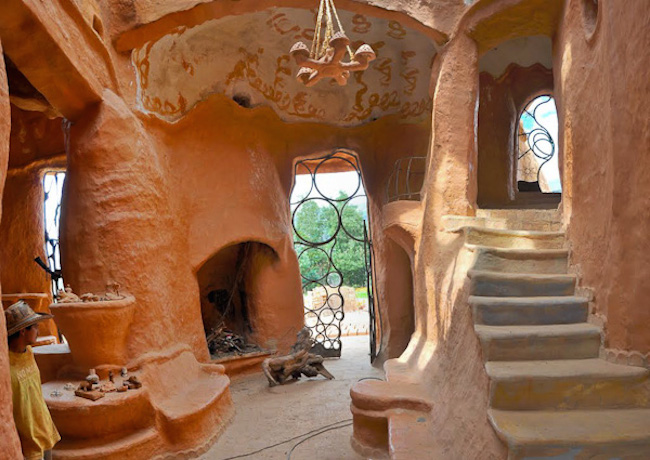It started as an experiment in sustainable building in Colombia, but quickly grew into something worthy of Ripley’s Believe It or Not. In 2012 Architect Octavio Mendoza completed the main portion of a building he calls Casa Terracota. Locals in the nearby town of Villa de Leyva, however, refer to it as Casa de Flinstones because, well, just look at the photographs.

According to travel writer Carol Pucci, the home is 5,400 square feet and is made entirely of local clay Mendoza fired. He now owns what he claims is the largest piece of pottery in the world. Visitors can visit the house and its spectacular view of the mountains for as little as $3.50. The home isn’t complete; on his web site the 64-year-old Mendoza predicts he will be working on the building for the rest of his life.
Mendoza describes the genesis of the project on his web site.
“Since I was a young boy I saw how artisans, architects and craftsmen transformed soil into various construction systems. Some of these were what we know as tapia pisada, adobe, bahareque, or simple soil blocks. Years after, once I had already graduated from my architectural studies at the Universidad Javeriana in Bogotá, I noticed how our cities and their buildings are usually made of millions of cooked bricks; all which constantly trigger consumption habits at very high rates as well as unconscious procedures that harm the planet. Even worse, I became aware of how that material’s shape and properties limits the way constructions are designed built and inhabited.
“Several years of reflecting on this phenomenon made me conclude, then, that there must be other ways of relating with spaces and the materials they are made of. That is how I determined to make a shift in the way I used all the techniques I had learned about; and in such shift I decided to use natural soil as my main material. This way I would create versatile works of art meant for our protection, rest and/or recreation.
“Later on the idea condensed itself into the concept of inhabiting one single giant brick; where everything we need for living (both structure and main objects) can be produced at a low cost rate.”
CFile will be posting soon on Ray Meeker’s similar projects in India.
Any thoughts about this post? Share yours in the comment box below.





Octavio Mendoza and Casa Terracota in Columbia.

Please correct every single place where the country is spelled COLUMBIA to the correct spelling: the country is COLOMBIA.
Unbelievable structure,
Can any1 please explain me the technique of this construction as it is a part of my architectural case study?
I will be very thankful!
Throw away the T-square and let it happen…I love it ! Inspiration for my next project as soon as I finish what I’ve been working on for 30 years and I’m 65, so I best get going.
I enjoy building earth ovens from on-site earth and clays.. this ‘casa’ is in my dreams… it is an amazing ‘build’…
an incredible handbuilt abode!
what are stuctural components unseen;beams,arches,floorjoists,headers. wood,concrete.steel,masonry? how is exterior treated to withstand weather?
I just visited today. There is no internal structure aside from the terracotta. The terracotta is backed by ovens erected by the artist. The outside is hardened by the ovens, but the inside is raw, making it resilient in earthquakes! It took 15 years to construct. It is terracotta pottery and is hardened with kilns erected piece by piece to be impermeable to water.
ColOmbia, not ColUmbia. One is a country, one is a university.
As an architect I find this very interesting. It appears to be monolithic so I am curious about how it was fired.
In N Africa smaller houses have been built this way – there, the structure is filled with wood fuel and piled over with it, then set ablaze to produce a soft brick bisque fired product. This structure must have required a large fire.
A beautiful structure with many fantastic incorporated elements (countertop, shelves, sinks etc.). However, it is not fired to brick, but just baked in the sun. I watched another video on YouTube which explained this. Thus it could collapse in an earthquake or if the exterior protection layer was breached by heavy rains for a period of time. A ceramic dome and vault type structure would be much more stable. I’m working on one this summer….we’ll see how it goes!